Evaluating People Management at LGI: A Talent Planning Report
VerifiedAdded on 2020/05/28
|21
|6031
|324
Report
AI Summary
This report provides an in-depth evaluation of people resource and talent planning issues at LGI, a site within The Leeds Teaching Hospitals NHS Trust. The report identifies key challenges, including a dictatorial work culture, high employee turnover, and a lack of clear codes of conduct and training policies. It analyzes the impact of these issues on the organization's performance, employee morale, and patient care. The report then suggests people management policies to complement the planned expansion of the organization, focusing on leadership qualities, talent acquisition improvements, and enhanced training and communication strategies. Furthermore, it evaluates LGI's current recruitment and selection processes, offering recommendations for a more structured approach. The report also discusses the application of relevant theories to overcome resistance to the proposed changes, considering legal compliance. The report concludes with recommendations to address the identified issues and improve the overall people management practices at LGI.
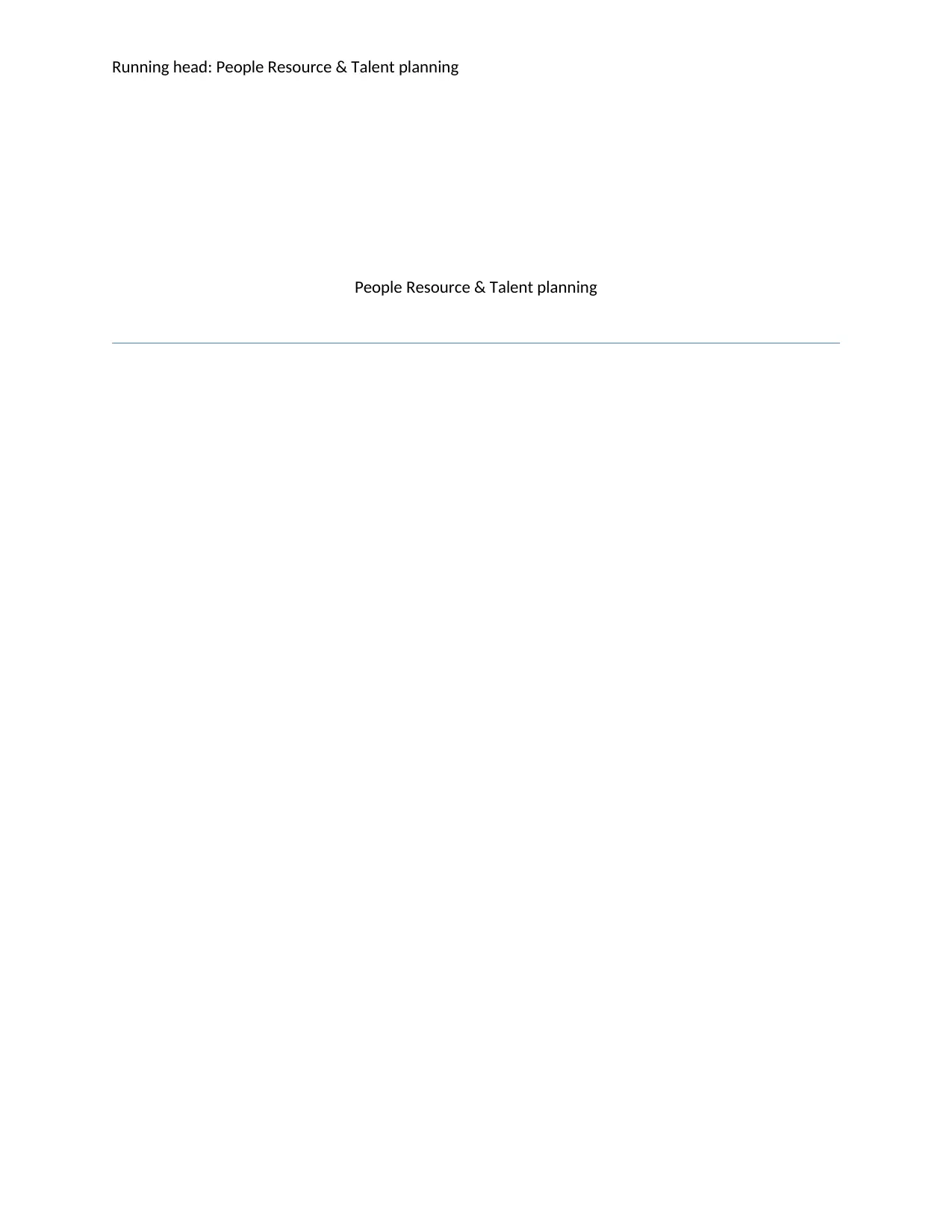
Running head: People Resource & Talent planning
People Resource & Talent planning
People Resource & Talent planning
Paraphrase This Document
Need a fresh take? Get an instant paraphrase of this document with our AI Paraphraser
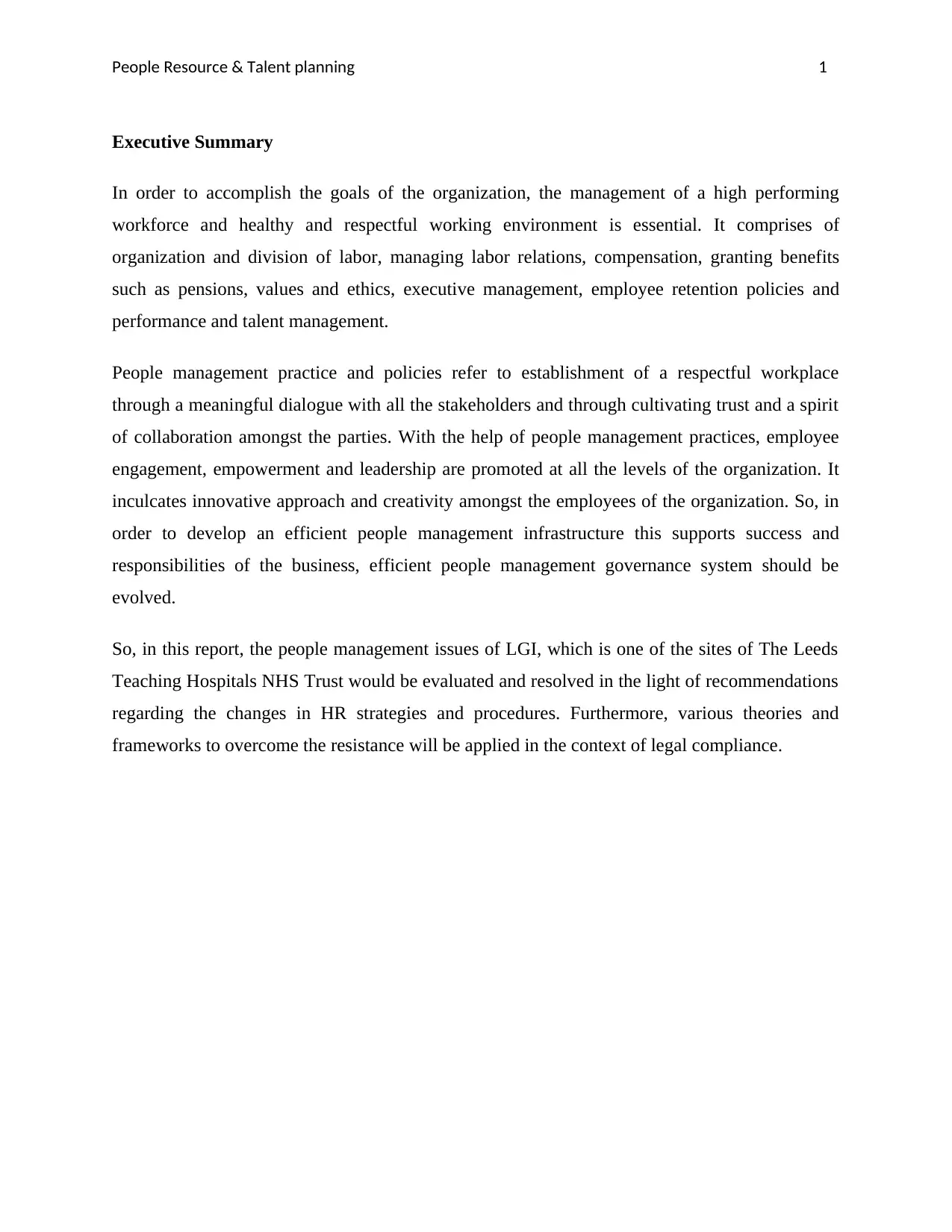
People Resource & Talent planning 1
Executive Summary
In order to accomplish the goals of the organization, the management of a high performing
workforce and healthy and respectful working environment is essential. It comprises of
organization and division of labor, managing labor relations, compensation, granting benefits
such as pensions, values and ethics, executive management, employee retention policies and
performance and talent management.
People management practice and policies refer to establishment of a respectful workplace
through a meaningful dialogue with all the stakeholders and through cultivating trust and a spirit
of collaboration amongst the parties. With the help of people management practices, employee
engagement, empowerment and leadership are promoted at all the levels of the organization. It
inculcates innovative approach and creativity amongst the employees of the organization. So, in
order to develop an efficient people management infrastructure this supports success and
responsibilities of the business, efficient people management governance system should be
evolved.
So, in this report, the people management issues of LGI, which is one of the sites of The Leeds
Teaching Hospitals NHS Trust would be evaluated and resolved in the light of recommendations
regarding the changes in HR strategies and procedures. Furthermore, various theories and
frameworks to overcome the resistance will be applied in the context of legal compliance.
Executive Summary
In order to accomplish the goals of the organization, the management of a high performing
workforce and healthy and respectful working environment is essential. It comprises of
organization and division of labor, managing labor relations, compensation, granting benefits
such as pensions, values and ethics, executive management, employee retention policies and
performance and talent management.
People management practice and policies refer to establishment of a respectful workplace
through a meaningful dialogue with all the stakeholders and through cultivating trust and a spirit
of collaboration amongst the parties. With the help of people management practices, employee
engagement, empowerment and leadership are promoted at all the levels of the organization. It
inculcates innovative approach and creativity amongst the employees of the organization. So, in
order to develop an efficient people management infrastructure this supports success and
responsibilities of the business, efficient people management governance system should be
evolved.
So, in this report, the people management issues of LGI, which is one of the sites of The Leeds
Teaching Hospitals NHS Trust would be evaluated and resolved in the light of recommendations
regarding the changes in HR strategies and procedures. Furthermore, various theories and
frameworks to overcome the resistance will be applied in the context of legal compliance.
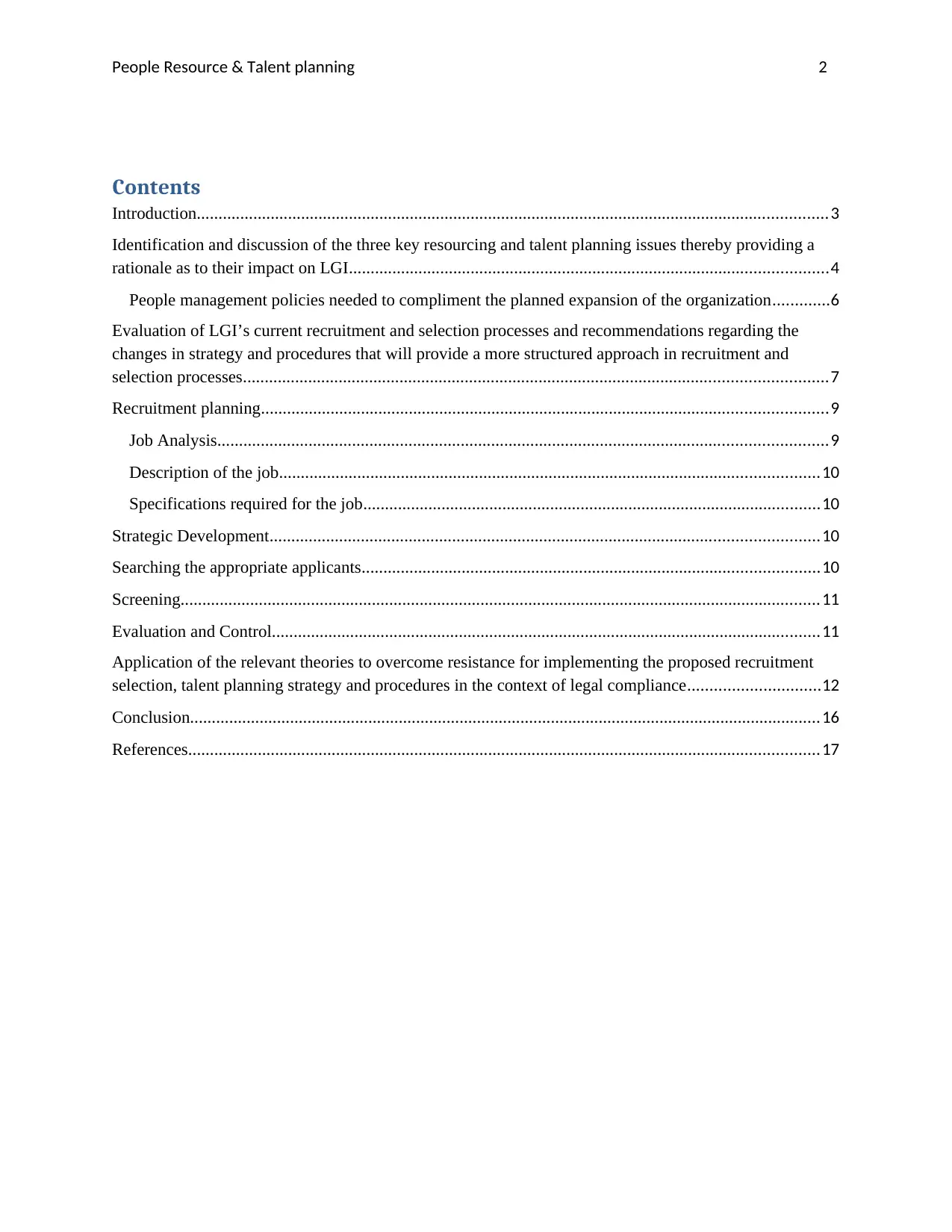
People Resource & Talent planning 2
Contents
Introduction.................................................................................................................................................3
Identification and discussion of the three key resourcing and talent planning issues thereby providing a
rationale as to their impact on LGI..............................................................................................................4
People management policies needed to compliment the planned expansion of the organization.............6
Evaluation of LGI’s current recruitment and selection processes and recommendations regarding the
changes in strategy and procedures that will provide a more structured approach in recruitment and
selection processes......................................................................................................................................7
Recruitment planning..................................................................................................................................9
Job Analysis............................................................................................................................................9
Description of the job............................................................................................................................10
Specifications required for the job.........................................................................................................10
Strategic Development..............................................................................................................................10
Searching the appropriate applicants.........................................................................................................10
Screening...................................................................................................................................................11
Evaluation and Control..............................................................................................................................11
Application of the relevant theories to overcome resistance for implementing the proposed recruitment
selection, talent planning strategy and procedures in the context of legal compliance..............................12
Conclusion.................................................................................................................................................16
References.................................................................................................................................................17
Contents
Introduction.................................................................................................................................................3
Identification and discussion of the three key resourcing and talent planning issues thereby providing a
rationale as to their impact on LGI..............................................................................................................4
People management policies needed to compliment the planned expansion of the organization.............6
Evaluation of LGI’s current recruitment and selection processes and recommendations regarding the
changes in strategy and procedures that will provide a more structured approach in recruitment and
selection processes......................................................................................................................................7
Recruitment planning..................................................................................................................................9
Job Analysis............................................................................................................................................9
Description of the job............................................................................................................................10
Specifications required for the job.........................................................................................................10
Strategic Development..............................................................................................................................10
Searching the appropriate applicants.........................................................................................................10
Screening...................................................................................................................................................11
Evaluation and Control..............................................................................................................................11
Application of the relevant theories to overcome resistance for implementing the proposed recruitment
selection, talent planning strategy and procedures in the context of legal compliance..............................12
Conclusion.................................................................................................................................................16
References.................................................................................................................................................17
⊘ This is a preview!⊘
Do you want full access?
Subscribe today to unlock all pages.

Trusted by 1+ million students worldwide
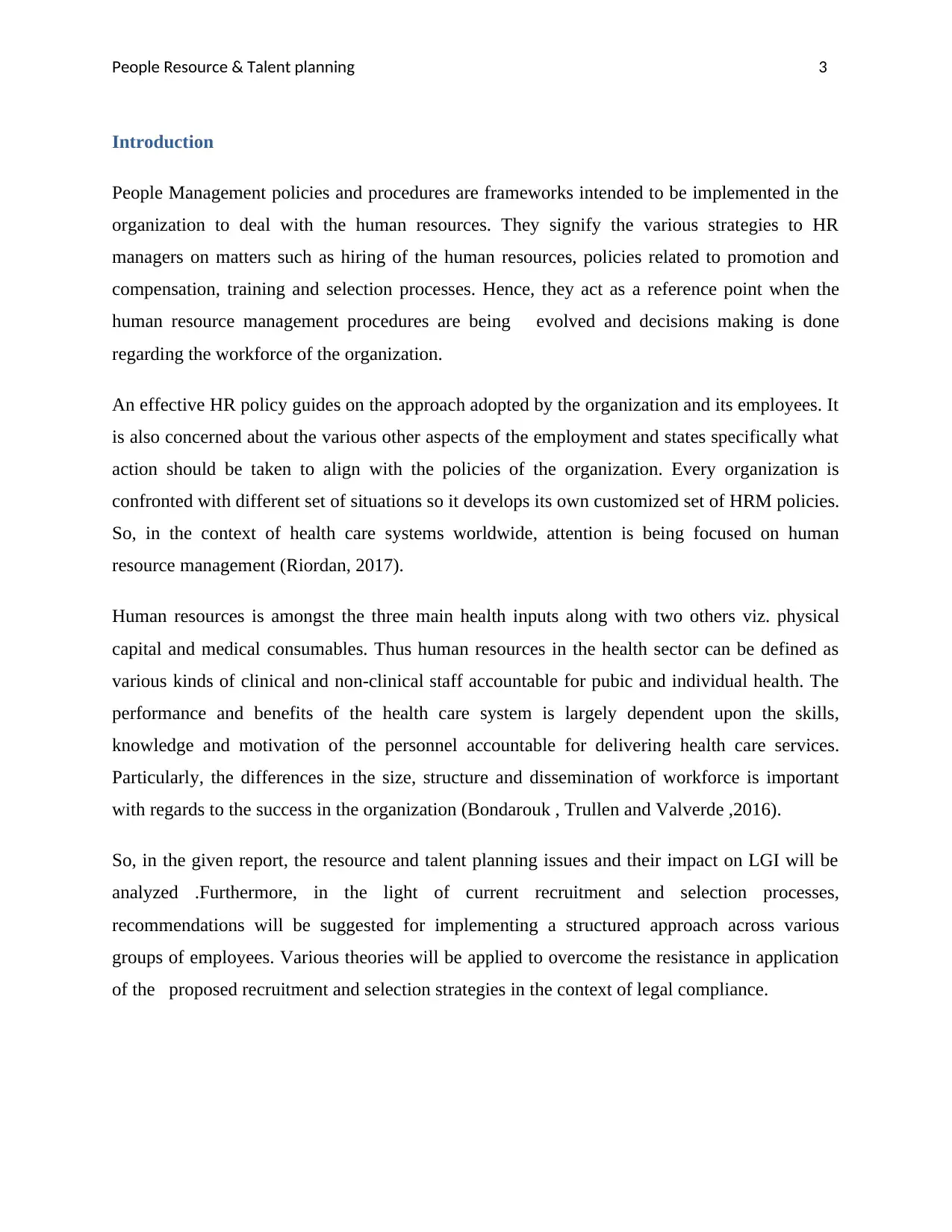
People Resource & Talent planning 3
Introduction
People Management policies and procedures are frameworks intended to be implemented in the
organization to deal with the human resources. They signify the various strategies to HR
managers on matters such as hiring of the human resources, policies related to promotion and
compensation, training and selection processes. Hence, they act as a reference point when the
human resource management procedures are being evolved and decisions making is done
regarding the workforce of the organization.
An effective HR policy guides on the approach adopted by the organization and its employees. It
is also concerned about the various other aspects of the employment and states specifically what
action should be taken to align with the policies of the organization. Every organization is
confronted with different set of situations so it develops its own customized set of HRM policies.
So, in the context of health care systems worldwide, attention is being focused on human
resource management (Riordan, 2017).
Human resources is amongst the three main health inputs along with two others viz. physical
capital and medical consumables. Thus human resources in the health sector can be defined as
various kinds of clinical and non-clinical staff accountable for pubic and individual health. The
performance and benefits of the health care system is largely dependent upon the skills,
knowledge and motivation of the personnel accountable for delivering health care services.
Particularly, the differences in the size, structure and dissemination of workforce is important
with regards to the success in the organization (Bondarouk , Trullen and Valverde ,2016).
So, in the given report, the resource and talent planning issues and their impact on LGI will be
analyzed .Furthermore, in the light of current recruitment and selection processes,
recommendations will be suggested for implementing a structured approach across various
groups of employees. Various theories will be applied to overcome the resistance in application
of the proposed recruitment and selection strategies in the context of legal compliance.
Introduction
People Management policies and procedures are frameworks intended to be implemented in the
organization to deal with the human resources. They signify the various strategies to HR
managers on matters such as hiring of the human resources, policies related to promotion and
compensation, training and selection processes. Hence, they act as a reference point when the
human resource management procedures are being evolved and decisions making is done
regarding the workforce of the organization.
An effective HR policy guides on the approach adopted by the organization and its employees. It
is also concerned about the various other aspects of the employment and states specifically what
action should be taken to align with the policies of the organization. Every organization is
confronted with different set of situations so it develops its own customized set of HRM policies.
So, in the context of health care systems worldwide, attention is being focused on human
resource management (Riordan, 2017).
Human resources is amongst the three main health inputs along with two others viz. physical
capital and medical consumables. Thus human resources in the health sector can be defined as
various kinds of clinical and non-clinical staff accountable for pubic and individual health. The
performance and benefits of the health care system is largely dependent upon the skills,
knowledge and motivation of the personnel accountable for delivering health care services.
Particularly, the differences in the size, structure and dissemination of workforce is important
with regards to the success in the organization (Bondarouk , Trullen and Valverde ,2016).
So, in the given report, the resource and talent planning issues and their impact on LGI will be
analyzed .Furthermore, in the light of current recruitment and selection processes,
recommendations will be suggested for implementing a structured approach across various
groups of employees. Various theories will be applied to overcome the resistance in application
of the proposed recruitment and selection strategies in the context of legal compliance.
Paraphrase This Document
Need a fresh take? Get an instant paraphrase of this document with our AI Paraphraser
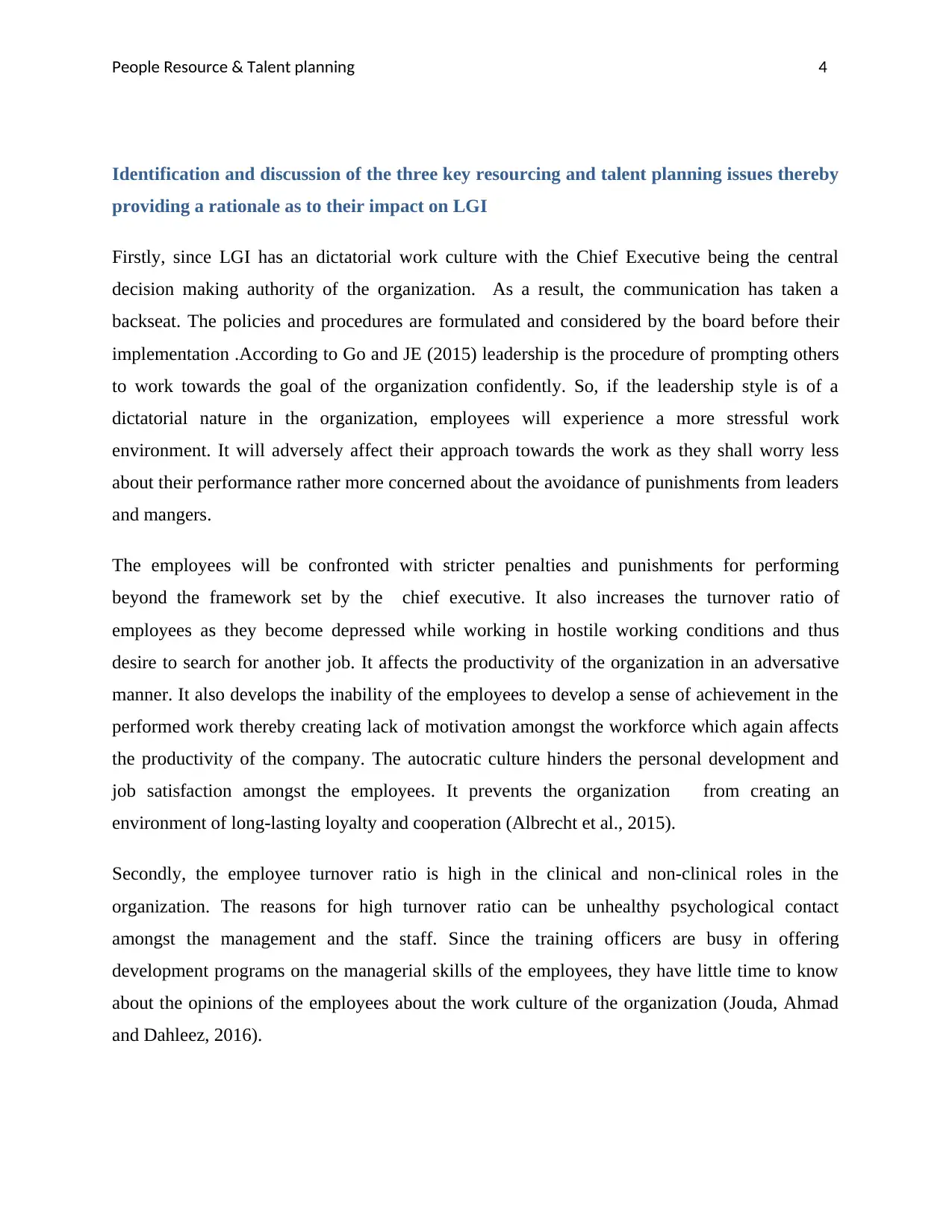
People Resource & Talent planning 4
Identification and discussion of the three key resourcing and talent planning issues thereby
providing a rationale as to their impact on LGI
Firstly, since LGI has an dictatorial work culture with the Chief Executive being the central
decision making authority of the organization. As a result, the communication has taken a
backseat. The policies and procedures are formulated and considered by the board before their
implementation .According to Go and JE (2015) leadership is the procedure of prompting others
to work towards the goal of the organization confidently. So, if the leadership style is of a
dictatorial nature in the organization, employees will experience a more stressful work
environment. It will adversely affect their approach towards the work as they shall worry less
about their performance rather more concerned about the avoidance of punishments from leaders
and mangers.
The employees will be confronted with stricter penalties and punishments for performing
beyond the framework set by the chief executive. It also increases the turnover ratio of
employees as they become depressed while working in hostile working conditions and thus
desire to search for another job. It affects the productivity of the organization in an adversative
manner. It also develops the inability of the employees to develop a sense of achievement in the
performed work thereby creating lack of motivation amongst the workforce which again affects
the productivity of the company. The autocratic culture hinders the personal development and
job satisfaction amongst the employees. It prevents the organization from creating an
environment of long-lasting loyalty and cooperation (Albrecht et al., 2015).
Secondly, the employee turnover ratio is high in the clinical and non-clinical roles in the
organization. The reasons for high turnover ratio can be unhealthy psychological contact
amongst the management and the staff. Since the training officers are busy in offering
development programs on the managerial skills of the employees, they have little time to know
about the opinions of the employees about the work culture of the organization (Jouda, Ahmad
and Dahleez, 2016).
Identification and discussion of the three key resourcing and talent planning issues thereby
providing a rationale as to their impact on LGI
Firstly, since LGI has an dictatorial work culture with the Chief Executive being the central
decision making authority of the organization. As a result, the communication has taken a
backseat. The policies and procedures are formulated and considered by the board before their
implementation .According to Go and JE (2015) leadership is the procedure of prompting others
to work towards the goal of the organization confidently. So, if the leadership style is of a
dictatorial nature in the organization, employees will experience a more stressful work
environment. It will adversely affect their approach towards the work as they shall worry less
about their performance rather more concerned about the avoidance of punishments from leaders
and mangers.
The employees will be confronted with stricter penalties and punishments for performing
beyond the framework set by the chief executive. It also increases the turnover ratio of
employees as they become depressed while working in hostile working conditions and thus
desire to search for another job. It affects the productivity of the organization in an adversative
manner. It also develops the inability of the employees to develop a sense of achievement in the
performed work thereby creating lack of motivation amongst the workforce which again affects
the productivity of the company. The autocratic culture hinders the personal development and
job satisfaction amongst the employees. It prevents the organization from creating an
environment of long-lasting loyalty and cooperation (Albrecht et al., 2015).
Secondly, the employee turnover ratio is high in the clinical and non-clinical roles in the
organization. The reasons for high turnover ratio can be unhealthy psychological contact
amongst the management and the staff. Since the training officers are busy in offering
development programs on the managerial skills of the employees, they have little time to know
about the opinions of the employees about the work culture of the organization (Jouda, Ahmad
and Dahleez, 2016).
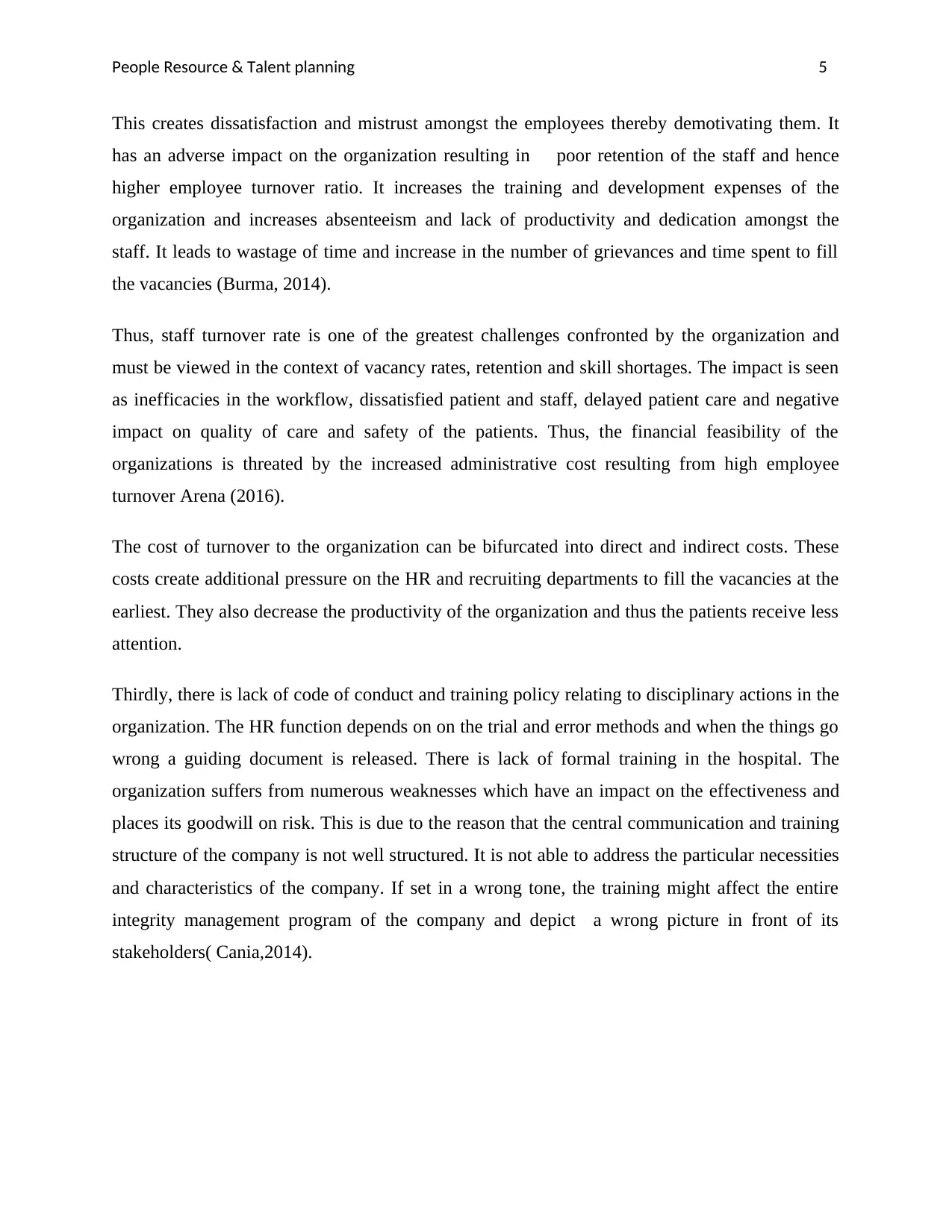
People Resource & Talent planning 5
This creates dissatisfaction and mistrust amongst the employees thereby demotivating them. It
has an adverse impact on the organization resulting in poor retention of the staff and hence
higher employee turnover ratio. It increases the training and development expenses of the
organization and increases absenteeism and lack of productivity and dedication amongst the
staff. It leads to wastage of time and increase in the number of grievances and time spent to fill
the vacancies (Burma, 2014).
Thus, staff turnover rate is one of the greatest challenges confronted by the organization and
must be viewed in the context of vacancy rates, retention and skill shortages. The impact is seen
as inefficacies in the workflow, dissatisfied patient and staff, delayed patient care and negative
impact on quality of care and safety of the patients. Thus, the financial feasibility of the
organizations is threated by the increased administrative cost resulting from high employee
turnover Arena (2016).
The cost of turnover to the organization can be bifurcated into direct and indirect costs. These
costs create additional pressure on the HR and recruiting departments to fill the vacancies at the
earliest. They also decrease the productivity of the organization and thus the patients receive less
attention.
Thirdly, there is lack of code of conduct and training policy relating to disciplinary actions in the
organization. The HR function depends on on the trial and error methods and when the things go
wrong a guiding document is released. There is lack of formal training in the hospital. The
organization suffers from numerous weaknesses which have an impact on the effectiveness and
places its goodwill on risk. This is due to the reason that the central communication and training
structure of the company is not well structured. It is not able to address the particular necessities
and characteristics of the company. If set in a wrong tone, the training might affect the entire
integrity management program of the company and depict a wrong picture in front of its
stakeholders( Cania,2014).
This creates dissatisfaction and mistrust amongst the employees thereby demotivating them. It
has an adverse impact on the organization resulting in poor retention of the staff and hence
higher employee turnover ratio. It increases the training and development expenses of the
organization and increases absenteeism and lack of productivity and dedication amongst the
staff. It leads to wastage of time and increase in the number of grievances and time spent to fill
the vacancies (Burma, 2014).
Thus, staff turnover rate is one of the greatest challenges confronted by the organization and
must be viewed in the context of vacancy rates, retention and skill shortages. The impact is seen
as inefficacies in the workflow, dissatisfied patient and staff, delayed patient care and negative
impact on quality of care and safety of the patients. Thus, the financial feasibility of the
organizations is threated by the increased administrative cost resulting from high employee
turnover Arena (2016).
The cost of turnover to the organization can be bifurcated into direct and indirect costs. These
costs create additional pressure on the HR and recruiting departments to fill the vacancies at the
earliest. They also decrease the productivity of the organization and thus the patients receive less
attention.
Thirdly, there is lack of code of conduct and training policy relating to disciplinary actions in the
organization. The HR function depends on on the trial and error methods and when the things go
wrong a guiding document is released. There is lack of formal training in the hospital. The
organization suffers from numerous weaknesses which have an impact on the effectiveness and
places its goodwill on risk. This is due to the reason that the central communication and training
structure of the company is not well structured. It is not able to address the particular necessities
and characteristics of the company. If set in a wrong tone, the training might affect the entire
integrity management program of the company and depict a wrong picture in front of its
stakeholders( Cania,2014).
⊘ This is a preview!⊘
Do you want full access?
Subscribe today to unlock all pages.

Trusted by 1+ million students worldwide
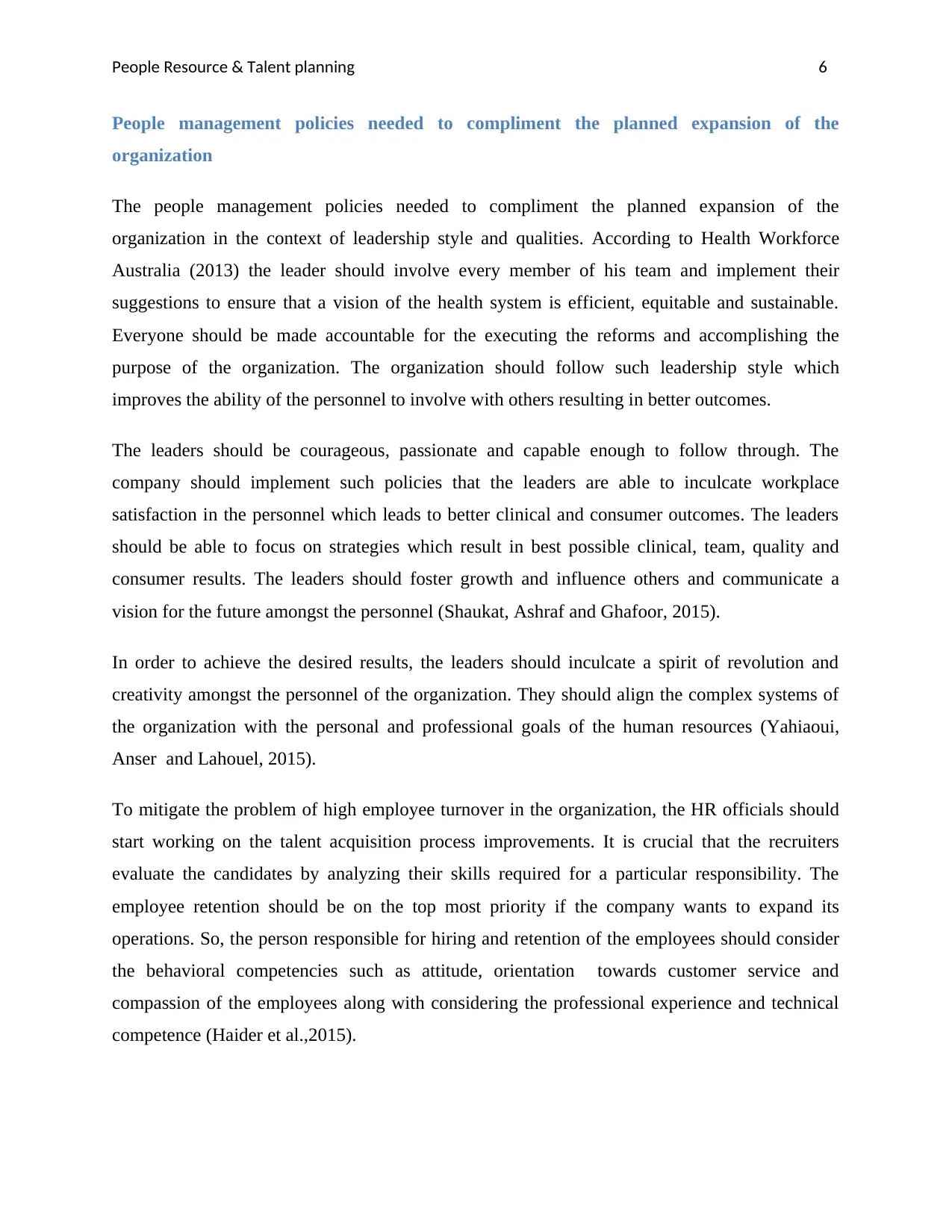
People Resource & Talent planning 6
People management policies needed to compliment the planned expansion of the
organization
The people management policies needed to compliment the planned expansion of the
organization in the context of leadership style and qualities. According to Health Workforce
Australia (2013) the leader should involve every member of his team and implement their
suggestions to ensure that a vision of the health system is efficient, equitable and sustainable.
Everyone should be made accountable for the executing the reforms and accomplishing the
purpose of the organization. The organization should follow such leadership style which
improves the ability of the personnel to involve with others resulting in better outcomes.
The leaders should be courageous, passionate and capable enough to follow through. The
company should implement such policies that the leaders are able to inculcate workplace
satisfaction in the personnel which leads to better clinical and consumer outcomes. The leaders
should be able to focus on strategies which result in best possible clinical, team, quality and
consumer results. The leaders should foster growth and influence others and communicate a
vision for the future amongst the personnel (Shaukat, Ashraf and Ghafoor, 2015).
In order to achieve the desired results, the leaders should inculcate a spirit of revolution and
creativity amongst the personnel of the organization. They should align the complex systems of
the organization with the personal and professional goals of the human resources (Yahiaoui,
Anser and Lahouel, 2015).
To mitigate the problem of high employee turnover in the organization, the HR officials should
start working on the talent acquisition process improvements. It is crucial that the recruiters
evaluate the candidates by analyzing their skills required for a particular responsibility. The
employee retention should be on the top most priority if the company wants to expand its
operations. So, the person responsible for hiring and retention of the employees should consider
the behavioral competencies such as attitude, orientation towards customer service and
compassion of the employees along with considering the professional experience and technical
competence (Haider et al.,2015).
People management policies needed to compliment the planned expansion of the
organization
The people management policies needed to compliment the planned expansion of the
organization in the context of leadership style and qualities. According to Health Workforce
Australia (2013) the leader should involve every member of his team and implement their
suggestions to ensure that a vision of the health system is efficient, equitable and sustainable.
Everyone should be made accountable for the executing the reforms and accomplishing the
purpose of the organization. The organization should follow such leadership style which
improves the ability of the personnel to involve with others resulting in better outcomes.
The leaders should be courageous, passionate and capable enough to follow through. The
company should implement such policies that the leaders are able to inculcate workplace
satisfaction in the personnel which leads to better clinical and consumer outcomes. The leaders
should be able to focus on strategies which result in best possible clinical, team, quality and
consumer results. The leaders should foster growth and influence others and communicate a
vision for the future amongst the personnel (Shaukat, Ashraf and Ghafoor, 2015).
In order to achieve the desired results, the leaders should inculcate a spirit of revolution and
creativity amongst the personnel of the organization. They should align the complex systems of
the organization with the personal and professional goals of the human resources (Yahiaoui,
Anser and Lahouel, 2015).
To mitigate the problem of high employee turnover in the organization, the HR officials should
start working on the talent acquisition process improvements. It is crucial that the recruiters
evaluate the candidates by analyzing their skills required for a particular responsibility. The
employee retention should be on the top most priority if the company wants to expand its
operations. So, the person responsible for hiring and retention of the employees should consider
the behavioral competencies such as attitude, orientation towards customer service and
compassion of the employees along with considering the professional experience and technical
competence (Haider et al.,2015).
Paraphrase This Document
Need a fresh take? Get an instant paraphrase of this document with our AI Paraphraser
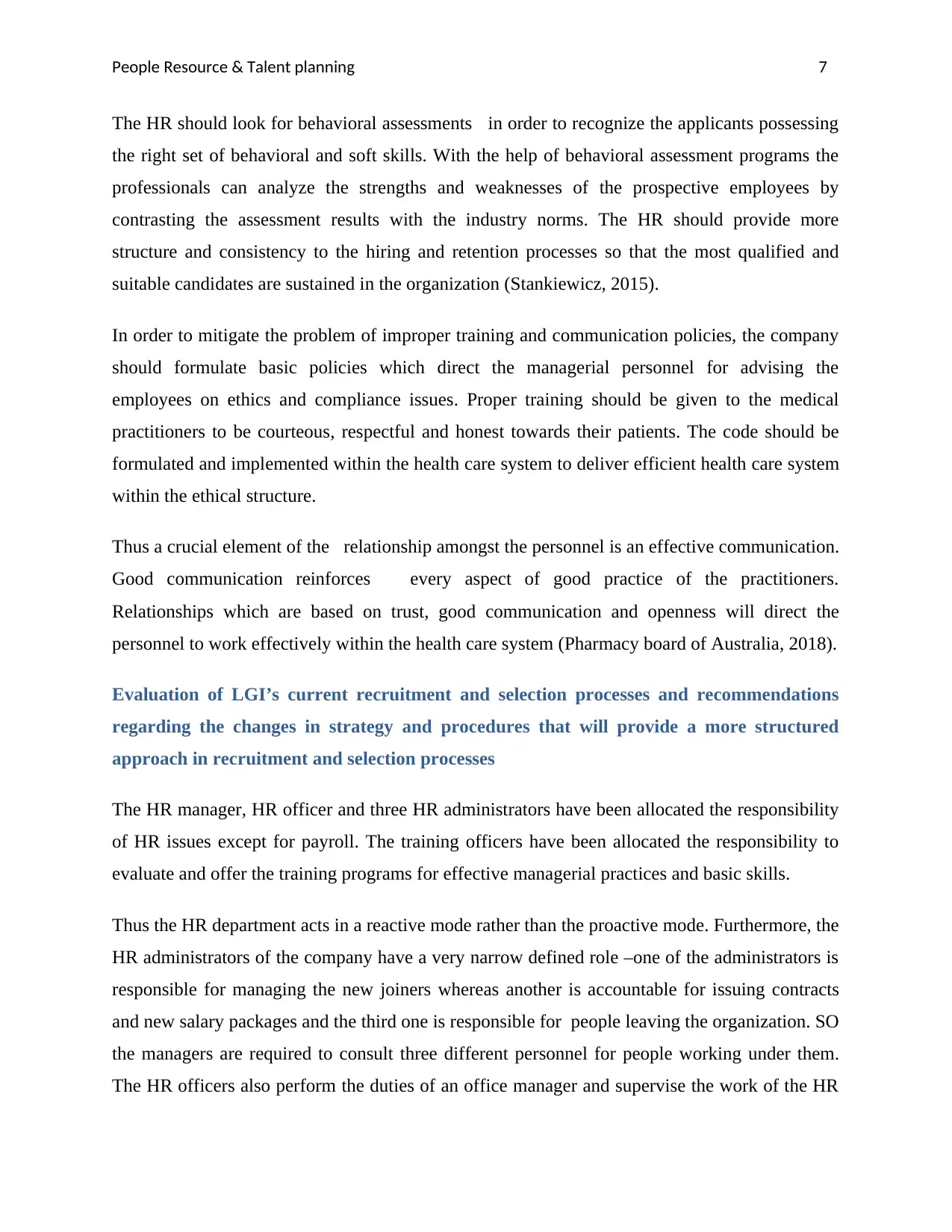
People Resource & Talent planning 7
The HR should look for behavioral assessments in order to recognize the applicants possessing
the right set of behavioral and soft skills. With the help of behavioral assessment programs the
professionals can analyze the strengths and weaknesses of the prospective employees by
contrasting the assessment results with the industry norms. The HR should provide more
structure and consistency to the hiring and retention processes so that the most qualified and
suitable candidates are sustained in the organization (Stankiewicz, 2015).
In order to mitigate the problem of improper training and communication policies, the company
should formulate basic policies which direct the managerial personnel for advising the
employees on ethics and compliance issues. Proper training should be given to the medical
practitioners to be courteous, respectful and honest towards their patients. The code should be
formulated and implemented within the health care system to deliver efficient health care system
within the ethical structure.
Thus a crucial element of the relationship amongst the personnel is an effective communication.
Good communication reinforces every aspect of good practice of the practitioners.
Relationships which are based on trust, good communication and openness will direct the
personnel to work effectively within the health care system (Pharmacy board of Australia, 2018).
Evaluation of LGI’s current recruitment and selection processes and recommendations
regarding the changes in strategy and procedures that will provide a more structured
approach in recruitment and selection processes
The HR manager, HR officer and three HR administrators have been allocated the responsibility
of HR issues except for payroll. The training officers have been allocated the responsibility to
evaluate and offer the training programs for effective managerial practices and basic skills.
Thus the HR department acts in a reactive mode rather than the proactive mode. Furthermore, the
HR administrators of the company have a very narrow defined role –one of the administrators is
responsible for managing the new joiners whereas another is accountable for issuing contracts
and new salary packages and the third one is responsible for people leaving the organization. SO
the managers are required to consult three different personnel for people working under them.
The HR officers also perform the duties of an office manager and supervise the work of the HR
The HR should look for behavioral assessments in order to recognize the applicants possessing
the right set of behavioral and soft skills. With the help of behavioral assessment programs the
professionals can analyze the strengths and weaknesses of the prospective employees by
contrasting the assessment results with the industry norms. The HR should provide more
structure and consistency to the hiring and retention processes so that the most qualified and
suitable candidates are sustained in the organization (Stankiewicz, 2015).
In order to mitigate the problem of improper training and communication policies, the company
should formulate basic policies which direct the managerial personnel for advising the
employees on ethics and compliance issues. Proper training should be given to the medical
practitioners to be courteous, respectful and honest towards their patients. The code should be
formulated and implemented within the health care system to deliver efficient health care system
within the ethical structure.
Thus a crucial element of the relationship amongst the personnel is an effective communication.
Good communication reinforces every aspect of good practice of the practitioners.
Relationships which are based on trust, good communication and openness will direct the
personnel to work effectively within the health care system (Pharmacy board of Australia, 2018).
Evaluation of LGI’s current recruitment and selection processes and recommendations
regarding the changes in strategy and procedures that will provide a more structured
approach in recruitment and selection processes
The HR manager, HR officer and three HR administrators have been allocated the responsibility
of HR issues except for payroll. The training officers have been allocated the responsibility to
evaluate and offer the training programs for effective managerial practices and basic skills.
Thus the HR department acts in a reactive mode rather than the proactive mode. Furthermore, the
HR administrators of the company have a very narrow defined role –one of the administrators is
responsible for managing the new joiners whereas another is accountable for issuing contracts
and new salary packages and the third one is responsible for people leaving the organization. SO
the managers are required to consult three different personnel for people working under them.
The HR officers also perform the duties of an office manager and supervise the work of the HR
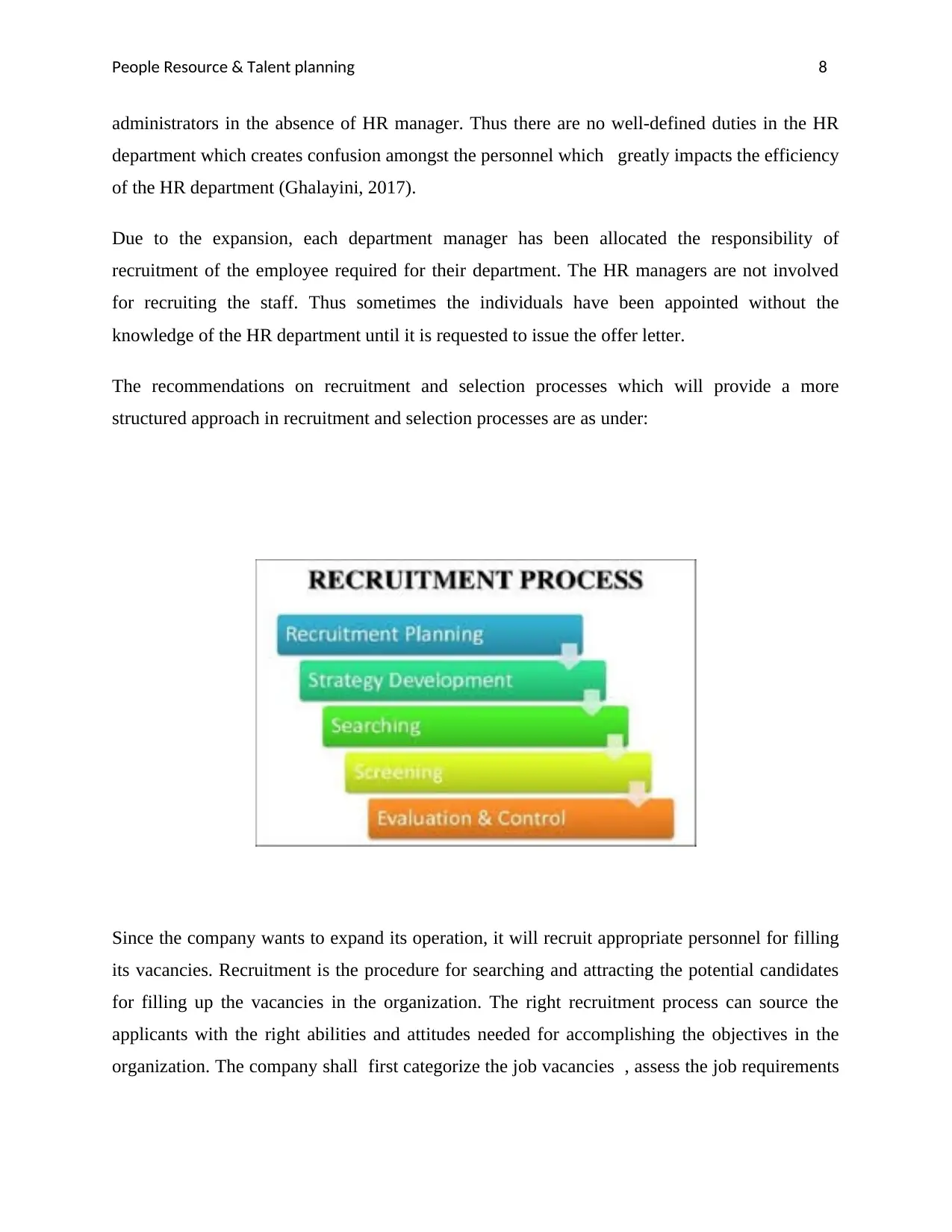
People Resource & Talent planning 8
administrators in the absence of HR manager. Thus there are no well-defined duties in the HR
department which creates confusion amongst the personnel which greatly impacts the efficiency
of the HR department (Ghalayini, 2017).
Due to the expansion, each department manager has been allocated the responsibility of
recruitment of the employee required for their department. The HR managers are not involved
for recruiting the staff. Thus sometimes the individuals have been appointed without the
knowledge of the HR department until it is requested to issue the offer letter.
The recommendations on recruitment and selection processes which will provide a more
structured approach in recruitment and selection processes are as under:
Since the company wants to expand its operation, it will recruit appropriate personnel for filling
its vacancies. Recruitment is the procedure for searching and attracting the potential candidates
for filling up the vacancies in the organization. The right recruitment process can source the
applicants with the right abilities and attitudes needed for accomplishing the objectives in the
organization. The company shall first categorize the job vacancies , assess the job requirements
administrators in the absence of HR manager. Thus there are no well-defined duties in the HR
department which creates confusion amongst the personnel which greatly impacts the efficiency
of the HR department (Ghalayini, 2017).
Due to the expansion, each department manager has been allocated the responsibility of
recruitment of the employee required for their department. The HR managers are not involved
for recruiting the staff. Thus sometimes the individuals have been appointed without the
knowledge of the HR department until it is requested to issue the offer letter.
The recommendations on recruitment and selection processes which will provide a more
structured approach in recruitment and selection processes are as under:
Since the company wants to expand its operation, it will recruit appropriate personnel for filling
its vacancies. Recruitment is the procedure for searching and attracting the potential candidates
for filling up the vacancies in the organization. The right recruitment process can source the
applicants with the right abilities and attitudes needed for accomplishing the objectives in the
organization. The company shall first categorize the job vacancies , assess the job requirements
⊘ This is a preview!⊘
Do you want full access?
Subscribe today to unlock all pages.

Trusted by 1+ million students worldwide
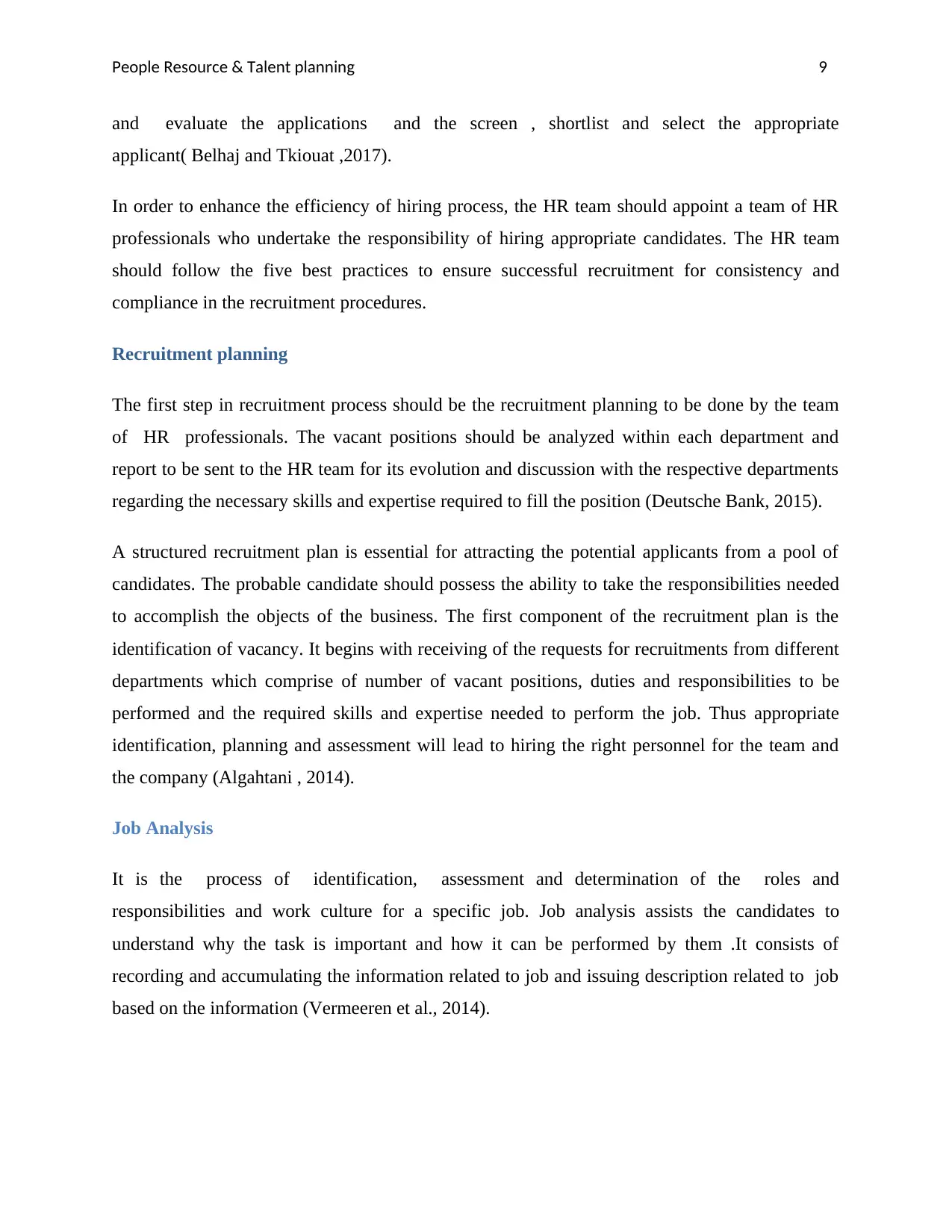
People Resource & Talent planning 9
and evaluate the applications and the screen , shortlist and select the appropriate
applicant( Belhaj and Tkiouat ,2017).
In order to enhance the efficiency of hiring process, the HR team should appoint a team of HR
professionals who undertake the responsibility of hiring appropriate candidates. The HR team
should follow the five best practices to ensure successful recruitment for consistency and
compliance in the recruitment procedures.
Recruitment planning
The first step in recruitment process should be the recruitment planning to be done by the team
of HR professionals. The vacant positions should be analyzed within each department and
report to be sent to the HR team for its evolution and discussion with the respective departments
regarding the necessary skills and expertise required to fill the position (Deutsche Bank, 2015).
A structured recruitment plan is essential for attracting the potential applicants from a pool of
candidates. The probable candidate should possess the ability to take the responsibilities needed
to accomplish the objects of the business. The first component of the recruitment plan is the
identification of vacancy. It begins with receiving of the requests for recruitments from different
departments which comprise of number of vacant positions, duties and responsibilities to be
performed and the required skills and expertise needed to perform the job. Thus appropriate
identification, planning and assessment will lead to hiring the right personnel for the team and
the company (Algahtani , 2014).
Job Analysis
It is the process of identification, assessment and determination of the roles and
responsibilities and work culture for a specific job. Job analysis assists the candidates to
understand why the task is important and how it can be performed by them .It consists of
recording and accumulating the information related to job and issuing description related to job
based on the information (Vermeeren et al., 2014).
and evaluate the applications and the screen , shortlist and select the appropriate
applicant( Belhaj and Tkiouat ,2017).
In order to enhance the efficiency of hiring process, the HR team should appoint a team of HR
professionals who undertake the responsibility of hiring appropriate candidates. The HR team
should follow the five best practices to ensure successful recruitment for consistency and
compliance in the recruitment procedures.
Recruitment planning
The first step in recruitment process should be the recruitment planning to be done by the team
of HR professionals. The vacant positions should be analyzed within each department and
report to be sent to the HR team for its evolution and discussion with the respective departments
regarding the necessary skills and expertise required to fill the position (Deutsche Bank, 2015).
A structured recruitment plan is essential for attracting the potential applicants from a pool of
candidates. The probable candidate should possess the ability to take the responsibilities needed
to accomplish the objects of the business. The first component of the recruitment plan is the
identification of vacancy. It begins with receiving of the requests for recruitments from different
departments which comprise of number of vacant positions, duties and responsibilities to be
performed and the required skills and expertise needed to perform the job. Thus appropriate
identification, planning and assessment will lead to hiring the right personnel for the team and
the company (Algahtani , 2014).
Job Analysis
It is the process of identification, assessment and determination of the roles and
responsibilities and work culture for a specific job. Job analysis assists the candidates to
understand why the task is important and how it can be performed by them .It consists of
recording and accumulating the information related to job and issuing description related to job
based on the information (Vermeeren et al., 2014).
Paraphrase This Document
Need a fresh take? Get an instant paraphrase of this document with our AI Paraphraser
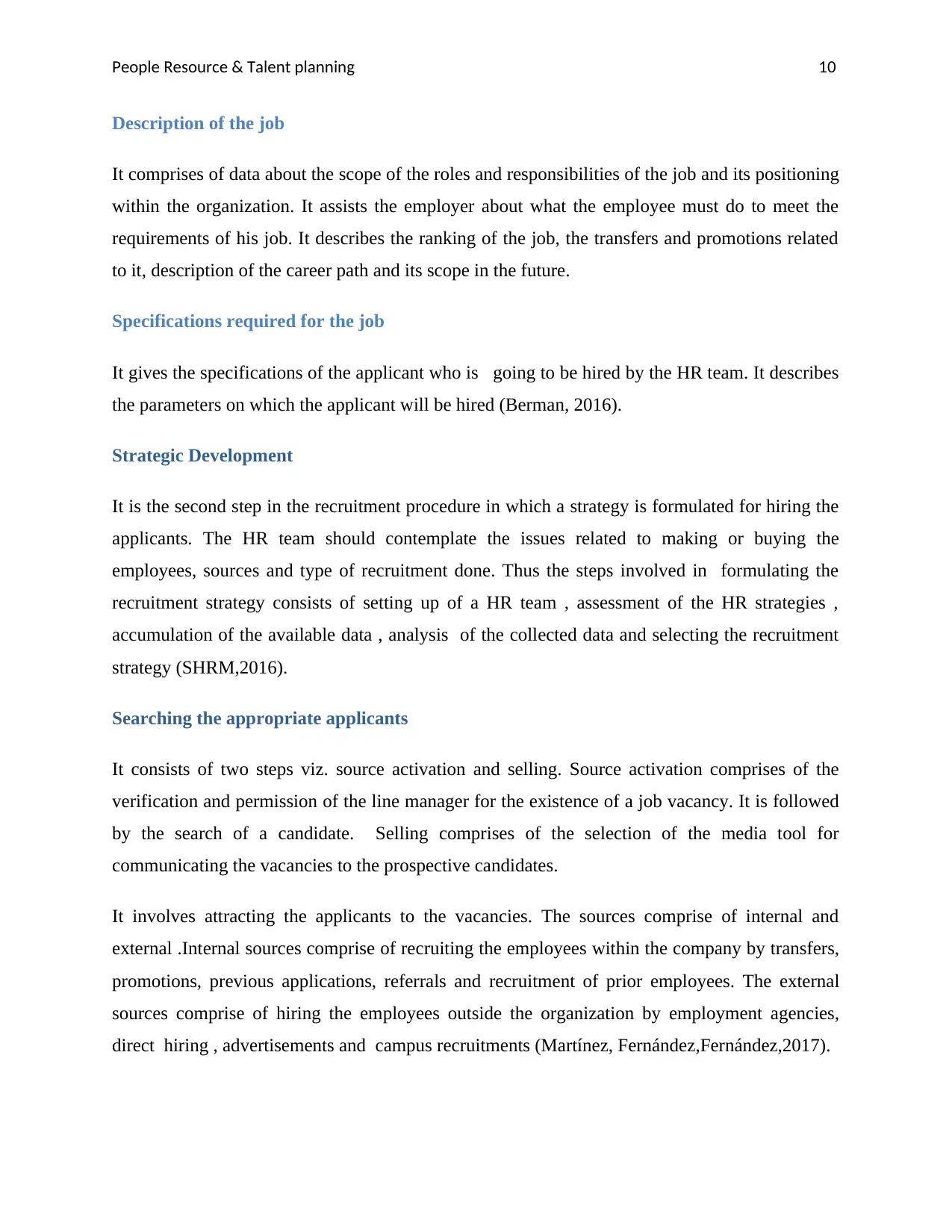
People Resource & Talent planning 10
Description of the job
It comprises of data about the scope of the roles and responsibilities of the job and its positioning
within the organization. It assists the employer about what the employee must do to meet the
requirements of his job. It describes the ranking of the job, the transfers and promotions related
to it, description of the career path and its scope in the future.
Specifications required for the job
It gives the specifications of the applicant who is going to be hired by the HR team. It describes
the parameters on which the applicant will be hired (Berman, 2016).
Strategic Development
It is the second step in the recruitment procedure in which a strategy is formulated for hiring the
applicants. The HR team should contemplate the issues related to making or buying the
employees, sources and type of recruitment done. Thus the steps involved in formulating the
recruitment strategy consists of setting up of a HR team , assessment of the HR strategies ,
accumulation of the available data , analysis of the collected data and selecting the recruitment
strategy (SHRM,2016).
Searching the appropriate applicants
It consists of two steps viz. source activation and selling. Source activation comprises of the
verification and permission of the line manager for the existence of a job vacancy. It is followed
by the search of a candidate. Selling comprises of the selection of the media tool for
communicating the vacancies to the prospective candidates.
It involves attracting the applicants to the vacancies. The sources comprise of internal and
external .Internal sources comprise of recruiting the employees within the company by transfers,
promotions, previous applications, referrals and recruitment of prior employees. The external
sources comprise of hiring the employees outside the organization by employment agencies,
direct hiring , advertisements and campus recruitments (Martínez, Fernández,Fernández,2017).
Description of the job
It comprises of data about the scope of the roles and responsibilities of the job and its positioning
within the organization. It assists the employer about what the employee must do to meet the
requirements of his job. It describes the ranking of the job, the transfers and promotions related
to it, description of the career path and its scope in the future.
Specifications required for the job
It gives the specifications of the applicant who is going to be hired by the HR team. It describes
the parameters on which the applicant will be hired (Berman, 2016).
Strategic Development
It is the second step in the recruitment procedure in which a strategy is formulated for hiring the
applicants. The HR team should contemplate the issues related to making or buying the
employees, sources and type of recruitment done. Thus the steps involved in formulating the
recruitment strategy consists of setting up of a HR team , assessment of the HR strategies ,
accumulation of the available data , analysis of the collected data and selecting the recruitment
strategy (SHRM,2016).
Searching the appropriate applicants
It consists of two steps viz. source activation and selling. Source activation comprises of the
verification and permission of the line manager for the existence of a job vacancy. It is followed
by the search of a candidate. Selling comprises of the selection of the media tool for
communicating the vacancies to the prospective candidates.
It involves attracting the applicants to the vacancies. The sources comprise of internal and
external .Internal sources comprise of recruiting the employees within the company by transfers,
promotions, previous applications, referrals and recruitment of prior employees. The external
sources comprise of hiring the employees outside the organization by employment agencies,
direct hiring , advertisements and campus recruitments (Martínez, Fernández,Fernández,2017).
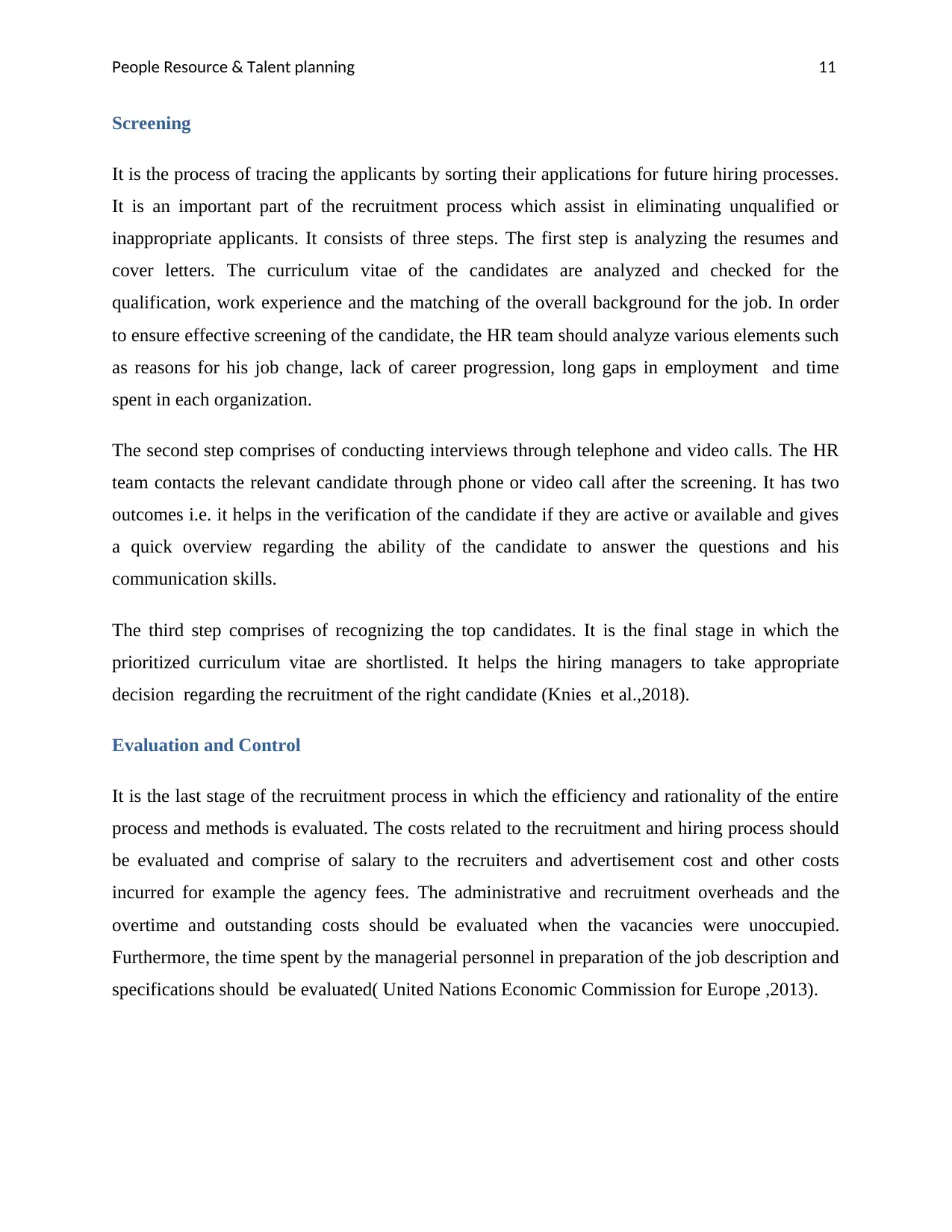
People Resource & Talent planning 11
Screening
It is the process of tracing the applicants by sorting their applications for future hiring processes.
It is an important part of the recruitment process which assist in eliminating unqualified or
inappropriate applicants. It consists of three steps. The first step is analyzing the resumes and
cover letters. The curriculum vitae of the candidates are analyzed and checked for the
qualification, work experience and the matching of the overall background for the job. In order
to ensure effective screening of the candidate, the HR team should analyze various elements such
as reasons for his job change, lack of career progression, long gaps in employment and time
spent in each organization.
The second step comprises of conducting interviews through telephone and video calls. The HR
team contacts the relevant candidate through phone or video call after the screening. It has two
outcomes i.e. it helps in the verification of the candidate if they are active or available and gives
a quick overview regarding the ability of the candidate to answer the questions and his
communication skills.
The third step comprises of recognizing the top candidates. It is the final stage in which the
prioritized curriculum vitae are shortlisted. It helps the hiring managers to take appropriate
decision regarding the recruitment of the right candidate (Knies et al.,2018).
Evaluation and Control
It is the last stage of the recruitment process in which the efficiency and rationality of the entire
process and methods is evaluated. The costs related to the recruitment and hiring process should
be evaluated and comprise of salary to the recruiters and advertisement cost and other costs
incurred for example the agency fees. The administrative and recruitment overheads and the
overtime and outstanding costs should be evaluated when the vacancies were unoccupied.
Furthermore, the time spent by the managerial personnel in preparation of the job description and
specifications should be evaluated( United Nations Economic Commission for Europe ,2013).
Screening
It is the process of tracing the applicants by sorting their applications for future hiring processes.
It is an important part of the recruitment process which assist in eliminating unqualified or
inappropriate applicants. It consists of three steps. The first step is analyzing the resumes and
cover letters. The curriculum vitae of the candidates are analyzed and checked for the
qualification, work experience and the matching of the overall background for the job. In order
to ensure effective screening of the candidate, the HR team should analyze various elements such
as reasons for his job change, lack of career progression, long gaps in employment and time
spent in each organization.
The second step comprises of conducting interviews through telephone and video calls. The HR
team contacts the relevant candidate through phone or video call after the screening. It has two
outcomes i.e. it helps in the verification of the candidate if they are active or available and gives
a quick overview regarding the ability of the candidate to answer the questions and his
communication skills.
The third step comprises of recognizing the top candidates. It is the final stage in which the
prioritized curriculum vitae are shortlisted. It helps the hiring managers to take appropriate
decision regarding the recruitment of the right candidate (Knies et al.,2018).
Evaluation and Control
It is the last stage of the recruitment process in which the efficiency and rationality of the entire
process and methods is evaluated. The costs related to the recruitment and hiring process should
be evaluated and comprise of salary to the recruiters and advertisement cost and other costs
incurred for example the agency fees. The administrative and recruitment overheads and the
overtime and outstanding costs should be evaluated when the vacancies were unoccupied.
Furthermore, the time spent by the managerial personnel in preparation of the job description and
specifications should be evaluated( United Nations Economic Commission for Europe ,2013).
⊘ This is a preview!⊘
Do you want full access?
Subscribe today to unlock all pages.

Trusted by 1+ million students worldwide
1 out of 21
Related Documents
Your All-in-One AI-Powered Toolkit for Academic Success.
+13062052269
info@desklib.com
Available 24*7 on WhatsApp / Email
![[object Object]](/_next/static/media/star-bottom.7253800d.svg)
Unlock your academic potential
Copyright © 2020–2025 A2Z Services. All Rights Reserved. Developed and managed by ZUCOL.





